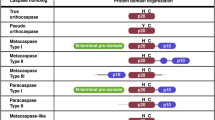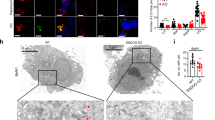Abstract
Paraptosis is mediated by several proteins, poly(ADP-ribose) polymerase being one of them. D. discoideum lacks caspases thus providing a better system to dissect out the role of PARP in paraptosis. The cell death phenotype in unicellular eukaryote, D. discoideum is similar to the programmed cell death phenotype of multicellular animals. However, the events downstream to the death signal of PCD in D. discoideum are yet to be understood. Our results emphasize that oxidative stress in D. discoideum lacking caspases leads to PARP activation, mitochondrial membrane potential changes, followed by the release of apoptosis inducing factor from mitochondria. AIF causes large scale DNA fragmentation, a hallmark feature of paraptosis. The role of PARP in paraptosis is reiterated via PARP inhibition by benzamide, PARG inhibition by gallotannin and PARP down-regulation, which delays paraptosis. PARP, PARG and AIF interplay is quintessential in paraptosis of D. discoideum. This is the first report to establish the involvement of PARP in the absence of caspase activity in D. discoideum which could be of evolutionary significance and gives a lead to understand the caspase independent paraptotic mechanism in higher organisms.









Similar content being viewed by others
Abbreviations
- PCD:
-
Programmed cell death
- PARP:
-
Poly(ADP-ribose) polymerase
- PARG:
-
Poly(ADP-ribose) glycohydrolase
- AIF:
-
Apoptosis inducing factor
- MMP:
-
Mitochondrial membrane potential
- ROS:
-
Reactive oxygen species
- H2O2 :
-
Cumene H2O2
- PS:
-
Phosphatidylserine
- PI:
-
Propidium iodide
References
Sperandio S, de Belle I, Bredesen DE (2000) An alternative, nonapoptotic form of programmed cell death. Proc Natl Acad Sci 97:14376–14381
Katoch B, Sebastians S, Sahdev S, Padh H, Hasnain SE, Begum R (2002) Programmed cell death and its clinical implications. Indian J Exp Biol 40:513–524
Yu S, Wang H, Poitras MF, Coombs C, Bowers WJ, Federoff H, Poirier GG, Dawson T, Dawson VL (2002) Mediation of poly(ADP-Ribose) polymerase-1-dependent cell death by apoptosis-inducing factor. Science 297:259–263
Rajawat J, Vohra I, Mir H, Gohel D, Begum R (2007) Effect of oxidative stress and involvement of poly(ADP-ribose) polymerase (PARP) in Dictyostelium discoideum development. FEBS J 274:5611–5618
Hasnain SE, Taneja TK, Sah NK, Mohan M, Pathak N, Sahdev S, Athar M, Begum R (1999) In vitro cultured Spodoptera frugiperda insect cells: model for oxidative stress-induced apoptosis. J Biosci 24:13–19
Sah NK, Taneja TK, Pathak N, Begum R, Athar M, Hasnain SE (1999) The baculovirus anti-apoptotic p35 gene also functions via an oxidant dependent pathway. Proc Natl Acad Sci (USA) 96:4838–4843
Mohan M, Taneja TK, Sahdev S, Krishnaveni M, Begum R, Athar M, Sah NK, Hasnain SE (2003) Antioxidants prevent UV-induced apoptosis by inhibiting mitochondrial cytochrome c release and caspase activation in Spodoptera frugiperda (Sf9) cells. Cell Biol Int 27:483–490
Burkley A (2001) Physiology and pathophysiology of poly(ADP-ribosyl)ation. BioEssays 23:795–806
Smulson ME, Simbulan-Rosenthal CM, Boulares AH (2000) Roles of poly(ADP-ribosyl)ation and PARP in apoptosis, DNA repair, genomic stability and functions of p53 and E2F-1. Adv Enzyme Regul 40:183–215
Hong SK, Dawson TM, Dawson VL (2004) Nuclear and mitochondrial conversations in cell death: PARP-1 and AIF signaling. Trends Pharmacol Sci 23:259–264
Otto H, Reche PA, Bazan F, Dittmar K, Haag F, Koch-Nolte F (2005) In silico characterization of the family of PARP-like poly(ADP-ribosyl)transferases (pARTs). BMC Genomics 6:139–161
Olie RA, Durrieu F, Cornillon S, Loughran G, Gross J, Earnshaw WC, Golstein P (1998) Apparent caspase independence of programmed cell death in Dictyostelium. Curr Biol 8:955–958
Mir H, Rajawat J, Pradhan S, Begum R (2007) Signaling molecules involved in the transition of growth to development of Dictyostelium discoideum. Indian J Exp Biol 45:223–236
Kawal AM, Mir H, Ramniklal CK, Rajawat J, Begum R (2011) Structural and evolutionary analysis of PARPs in D. discoideum. Am J Infect Dis 7:67–74
Kawli T, Venkatesh BR, Kennady PK, Pande G, Nanjundiah V (2002) Correlates of developmental cell death in Dictyostelium discoideum. Differentiation 70:272–281
Roisin-Bouffay C, Luciani MF, Klein G, Levraud JP, Adam M, Golstein P (2004) Developmental cell death in Dictyostelium does not require paracaspase. J Biol Chem 279:11489–11494
Katoch B, Begum R (2003) Biochemical basis of the high resistance to oxidative stress in Dictyostelium discoideum. J Biosci 28:581–588
Rajawat J, Mir H, Begum R (2011) Differential role of poly(ADP-ribose) polymerase in D. discoideum growth and development. BMC Dev Biol 11:14
Watts DJ, Ashworth JM (1970) Growth of myxamoebae of the cellular slime mould Dictyostelium discoideum in axenic culture. Biochem J 119:171–174
Szabo C, Dawson VL (1998) Role of Poly(ADP-ribose) synthetase in inflammation and ischaemia-reperfusion. Trends Pharmacol Sci 19:287–298
Kosta A, Laporte C, Lam D, Tresse E, Luciani MF, Golstein P (2006) How to assess and study cell death in Dictyostelium discoideum. Methods Cell Biol 346:535–550
Cole KK, Perez-Polo JR (2002) Poly(ADP-ribose) polymerase inhibition prevents both apoptotic-like delayed neuronal death and necrosis after H2O2 injury. J Neurochem 82:19–29
Bernofsky C, Swan M (1973) An improved cycling assay for nicotinamide adenine dinucleotide. Anal Biochem 53:452–458
Lowry OH, Rosebrough NJ, Farr AL, Randall RJ (1951) Protein measurement with the Folin phenol reagent. J Biol Chem 193:265–275
Leoncini G, Buzzi E, Maresca M, Mazzel M, Balbi A (1987) Alkaline extraction and reverse phase high-performance liquid chromatography of adenine and pyridine nucleotides in human platelets. Anal Biochem 165:379–383
Koning AJ, Lum PY, Williams JM, Wright R (1993) DiOC6 staining reveals organelle structure and dynamics in living yeast cells. Cell Motil Cytoskelet 25:111–128
Cossarizza A, Salvioli S (2001) Flow cytometric analysis of mitochondrial membrane potential using JC-1. Curr Protoc Cytom 9:9.14.1–9.14.7
Bidere N, Lorenzo HK, Carmona S, Laforge M, Harper F, Dumont C, Senik A (2003) Cathepsin D triggers Bax activation, resulting in selective apoptosis-inducing factor (AIF) relocation in T lymphocytes entering the early commitment phase to apoptosis. J Biol Chem 278:31401–33141
Gavrieli Y, Sherman Y, Ben-Sasson SA (1992) Identification of programmed cell death in situ via specific labeling of nuclear DNA fragmentation. J Cell Biol 119:493–501
Cornillon S, Foa C, Davoust J, Buonavista N, Gross JD, Golstein P (1994) Programmed cell death in Dictyostelium. J Cell Sci 107(Pt 10):2691–2704
Kosta A, Roisin-Bouffay C, Luciani MF, Otto GP, Kessin RH, Golstein P (2004) Autophagy gene disruption reveals a non-vacuolar cell death pathway in Dictyostelium. J Biol Chem 279:48404–48409
Arnoult D, Tatischeff I, Estaquier J, Girard M, Sureau F, Tissier JP, Grodet A, Dellinger M, Traincard F, Kahn A (2001) On the evolutionary conservation of the cell death pathway: mitochondrial release of an apoptosis-inducing factor during Dictyostelium discoideum cell death. Mol Biol Cell 12:3016–3030
Lam D, Levraud JP, Luciani M, Golstein P (2007) Autophagic or necrotic cell death in the absence of caspase and bcl-2 family members. Biochem Biophys Res Commun 363:536–541
Palomba L, Sestili P, Cattabeni F, Azzi A, Cantoni O (1996) Prevention of necrosis and activation of apoptosis in oxidatively injured human myeloid leukemia U937 cells. FEBS Lett 390:91–94
Schraufstatter IU, Hyslop PA, Hinshaw DB, Spragg RG, Sklar LA, Cochrane CG (1986) Hydrogen peroxide-induced injury of cells and its prevention by inhibitors of Poly(ADP-ribose) polymerase. Proc Natl Acad Sci 83:4908–4912
Watson AJ, Askew JN, Benson RS (1995) Poly(adenosine diphosphate ribose) polymerase inhibition prevents necrosis induced by H2O2 but not apoptosis. Gastroenterology 109:472–482
Henrie MS, Kurimasa A, Burma S, de Murcia JM, de Murcia G, Li GC, Chen DJ (2003) Lethality in PARP-1/Ku80 double mutant mice reveals physiological synergy during early embryogenesis. DNA Repair (Amst) 2:151–158
Ciprani H, Rapizzi E, Vannacci A, Rizzuto R, Moroni F, Chiarugi A (2005) Nuclear poly(ADP-ribose) polymerase-I rapidly triggers mitochondrial dysfunction. J Biol Chem 280:17227–17234
Mathews MT, Berk BC (2008) PARP-1 inhibition prevents oxidative and nitrosative stress induced endothelial cell death via transactivation of the VEGF receptor 2. Arterioscler Thromb Vasc Biol 28:711–717
Kim H, Jacobson EL, Jacobson MK (1994) NAD Glycohydrolases: a possible function in calcium homeostasis. Mol Cell Biochem 138:237–243
Mir H, Rajawat J, Begum R (2012) Staurosporine induced cell death in D. discoideum is independent of PARP. Indian J Exp Biol 50:80–86
Tapodi A, Debreceni B, Hanto K, Bognar Z, Wittmann I, Gallyas F, Varbiro G, Sumegi B (2005) Pivotal role of Akt activation in mitochondrial protection and cell survival by Poly(ADP-ribose) polymerase-1 inhibition in oxidative stress. J Biol Chem 280:35767–35775
Ying W, Sevigny MB, Chen Y, Swanson RA (2001) Poly (ADP-ribose) glycohydrolase mediates oxidative and excitotoxic neuronal death. Proc Natl Acad Sci USA 98:12227–12232
Kang YH, Yi MJ, Kim MJ, Park MT, Bae S, Kang CM, Cho CK, Park IC, Park MJ, Rhee CH et al (2004) Caspase-independent cell death by arsenic trioxide in human cervical cancer cells: reactive oxygen species-mediated Poly(ADP-ribose) polymerase-1 activation signals apoptosis-inducing factor release from mitochondria. Cancer Res 64:8960–8967
Lee M, Cho T, Jantaratnotai N, Wang YT, McGeer E, McGeer PL (2010) Depletion of GSH in glial cells induces neurotoxicity: relevance to aging and degenerative neurological diseases. FASEB J 24:2533–2545
Acknowledgments
RB thanks the Department of Biotechnology, New Delhi (BT/PR9496/BRB/10/562/2007) and Department of Science and Technology, New Delhi (SR/SO/BB-03/2010) for research support. JR thanks Council Scientific Research, New Delhi for awarding JRF/SRF. We thank DBT-MSUB-ILSPARE program for providing the FACS and Confocal facilities. We also thank Dr. Shweta Saran for generous gift of vectors. Our sincere thanks are to Ms. Bandhana Katoch from M.S. University of Baroda, Vadodara; Prof. V. Nanjundiah and Dr. Ritwick Sarwarkar from Indian Institute of Science, Bangalore for their help in standardization of the fluorescence techniques.
Author information
Authors and Affiliations
Corresponding author
Rights and permissions
About this article
Cite this article
Rajawat, J., Mir, H., Alex, T. et al. Involvement of poly(ADP-ribose) polymerase in paraptotic cell death of D. discoideum . Apoptosis 19, 90–101 (2014). https://doi.org/10.1007/s10495-013-0920-9
Published:
Issue Date:
DOI: https://doi.org/10.1007/s10495-013-0920-9




